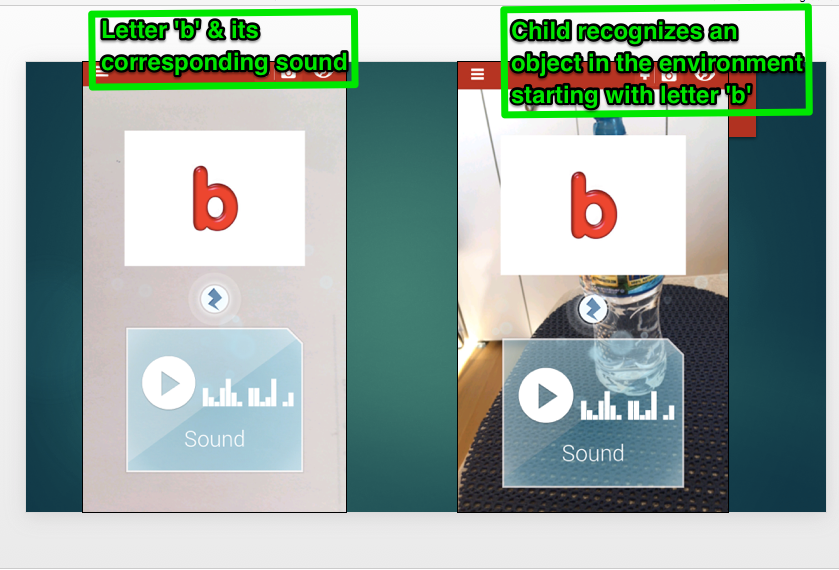ReadAlive
A mobile and tablet-based app for children to learn & practice Letter-Sound connection using the interactive environment of Augmented Reality
Role
Product Designer
Tasks
Product Conceptualization; UX Design & Research;
Storyboarding; Rapid Prototyping
Format
Mobile- & Tablet- based app
Tools
Zappar; Adobe Photoshop;
Adobe Illustrator
Problem
The term ‘learning disabilities’ refers to a group of disorders characterized by difficulties in several academic abilities (e.g. speaking, reading, writing or working with numbers). It has been stated that 3.5% of the students suffer from reading problems and Dyslexia, by far, is one of the most common learning disabilities (Bjšrklund, 2011). Students with dyslexia have severe difficulty in reading, spellings and language which makes it difficult for them to cope with the standard curriculum followed in classrooms. Due to this they commit errors in written and oral expression (Abasa & Zamanb, 2009).
A study by Obradovic et al. (2015) suggested that dyslexic students can be benefited from “creative interactive activities, visual presentations, project-based learning, school experiments, which are based on student engagement and activities”.
AR systems/applications enable users to sense properties about the real world, process in real time, use visual, audio, and haptic means overlaid on the real world and the use of mobile or wearable devices (Roesner, et al., 2014). Its capability to combine the real world with virtual content presents new possibilities for learning that could be proved extremely beneficial for students with learning disabilities (Karamanoli & Tsinakos, 2015).
Solution
Inspired by these researches and by my own personal experiences of working with dyslexic children in the past, I decided to create "ReadAlive" which uses the affordances of AR to help children establish the grapheme-phoneme correspondence, that is, the letter-sound connection. The use of AR enables the letters to come “alive” along with its associated sound. The app will also allow the child to practice letter formation and object recognition in the AR environment. These features can be directly mapped on the skill deficits and challenges faced by children with Dyslexia.


Target Audience
- Children who have been diagnosed with learning disabilities specially Dyslexia.
- Children in the age range of 3-6 years will benefit the most out of the product. But children more than 6 years old who have issues with letter-sound connection can also use this app.
- The app can only be used to learn English alphabets and is currently not supporting other languages.
- It can be used for students in schools as well as by parents and caregivers at home.
Learning Goals
- Learn the alphabets and their associated sounds (grapheme-phoneme correspondence)
- Visualize words with images for better retention in the long-term
- Practice letter formation by understanding its particular sound
- Explore the environment to find objects starting with the particular letter.
Product Demonstration
Children with Dyslexia have also been found to commit errors in writing because they tend to write ‘b’ instead of ‘d’ or ‘p’ instead of ‘q’ and vice versa. It generally happens due to the deficit in letter-sound connection due to which they get confused between the letter formation. Through the app, the child will be able to practice letter formation along with the sound associated with it.
The affordance of the AR technology used in the app will be that the child can explore the surrounding environment to spot things and objects starting with that particular letter. For example, finding objects starting with the letter ‘a’ such as apple, arm, etc. Visualizing images associated with that letter will help them retain that information for a longer period of time.
The following storyboards depict a snapshot of the user experience for the product:


Please follow these steps to view the digital prototype of AR experience:
1. Download the Zappar app on your mobile phone.
2. Download the image from the Google Drive folder (link here).
3. Scan the ZapCode from the mobile device.
4. The letter will pop up in the AR environment. Click on the sound icon to hear the sound associated with the letter.
To make this experience more engaging, parents can work together with their kids to construct a story around the objects that the child recognizes for one letter. By tapping into their potential of creativity and using this strategy, it will provide a context for the child to remember and retain this information. An interactive learning environment & appropriate reinforcement can go a long way in encouraging the learner to go go above and beyond their abilities.
Theoretical Framework
Design decisions & product mechanisms have been informed by the following learning theories:
- Embodied Cognition
- Affective Learning Theory
- Constructivism
For a detailed description of the project & references, please access the design document here.
Supervised by: Emily Reardon